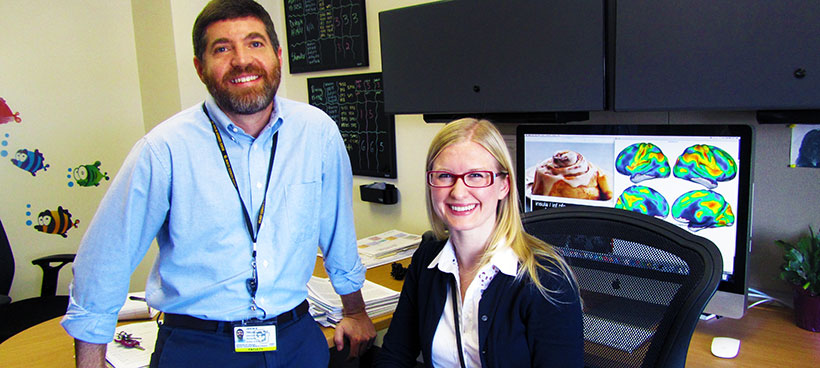The Disgust Diet
Using Repulsive Pictures to Change Food Choices

By Mark Couch
(December 2015) Can a picture of a cockroach on a piece of pizza–flashing by so fast that your brain registers the image but you don’t realize that you’ve seen it–change your food choices?
University of Colorado School of Medicine researcher Kristina Legget, PhD, assistant professor of psychiatry, is exploring that question with experiments that test a process called “implicit priming.”
“We were thinking about the way we are bombarded by food cues and manipulated with what we choose to eat,” Legget says. “Thinking of the ads that we hear and see—Heidi Klum with a big burger that she’s eating—we were thinking, ‘Is there a way to combat that at a visceral level’ rather than having to think all the time, ‘No, I shouldn’t have a doughnut even though that sounds really good.’”
In other words, can a person’s brain be trained to associate high-calorie food choices with repulsive images? Call it the disgust diet.
“My main field is obesity neurobiology,” says Legget. “I study the neurobiology of food-intake behaviors and obesity. We look at a number of different interventions and I’m particularly interested in cognitive approaches.”
Legget and her colleagues wondered if it was possible to sneak an image into a person’s memory so that they might be deterred without having to think so hard about the consequences of bad eating habits. And if such an approach worked, how long would that connection between a repulsive image and a food choice last in the person’s memory?
“There’s an interesting study that investigated product placement on TV,” says Legget. “They showed episodes of ‘Seinfeld’ and asked people to complete a simulated shopping test afterwards. The items that were obvious product placements—like Jerry saying, ‘ooh, this is a good Coke,’—were chosen less often because they felt like they were being manipulated.
“But if it was really subtle, such as Tide in the background, the Tide was chosen more frequently, because it was primed, but not in an obvious way. That’s one reason why we thought it would be more interesting to see if we could influence preferences on a subconscious level.”
The study by Legget and her colleagues, published this past summer in The American Journal of Clinical Nutrition, found evidence that implicit priming alters high-calorie food preference and that the change in preference persisted for three to five days after the implicit priming.
The experiment took 42 people through a process of viewing images of food spliced with millisecond bursts of other images to test whether those flashes—so fast that the test subjects had no conscious memory of seeing them—would influence food choices.
Twenty-two of the test subjects were shown high-calorie food images and negative images, such as a broken bone protruding from a body, a cockroach on a pizza, or vomit on an unclean toilet. They were also shown images of low-calorie foods, like salads or fruit, paired with flashes of positive images, such as kittens, a smiling baby and a butterfly on a flower. The other 20 participants were shown the same food images, but they were not shown the priming images.
Participants were told they would see food pictures, preceded by a brief presentation of images with emotional content. Immediately after the task, participants rated the foods on a desire to eat them. Those who were flashed the disgusting images were less likely to prefer the subsequent high-calorie foods they were shown. And when those participants were retested three to five days later, they still showed reduced interest in the high-calorie foods.
Legget concluded that the implicit priming “could be a successful tactic to combat the onslaught of food cues that promote unhealthy eating by conditioning automatic food preferences in a way that promotes better choices in the absence of focused cognitive effort.”
Investigating the behavior is just a first step in a deeper inquiry for Legget and her colleague, Jason Tregellas, PhD, associate professor of psychiatry.
“The behavioral finding is great,” says Legget. “It’s great that we’re seeing behavioral results, but the next key is to see whether it affects the brain the way we think it does. In addition changing ratings of food pictures, is it going to change how your brain responds to those food pictures?”
They have received a grant from the National Institutes of Health to look at neuroimaging in this context. They have also recently acquired a new MRI scanner though a National Institutes of Health high-end instrumentation grant to use in the next round of testing and are beginning the new round of experiments.
The goal is to help people eat better foods and lead healthier lives, says Legget.
“It’s very hard to avoid the cues that are coming at you,” Legget says. “They’re all automatically processed, including how things are placed in the grocery store, how things look on a menu, how they make things smell. There are all kinds of manipulations to make you eat what people want you to eat. That’s what they do. We like to see our research as a weapon to combat this onslaught of food cues telling us to eat those yummy doughnuts.”